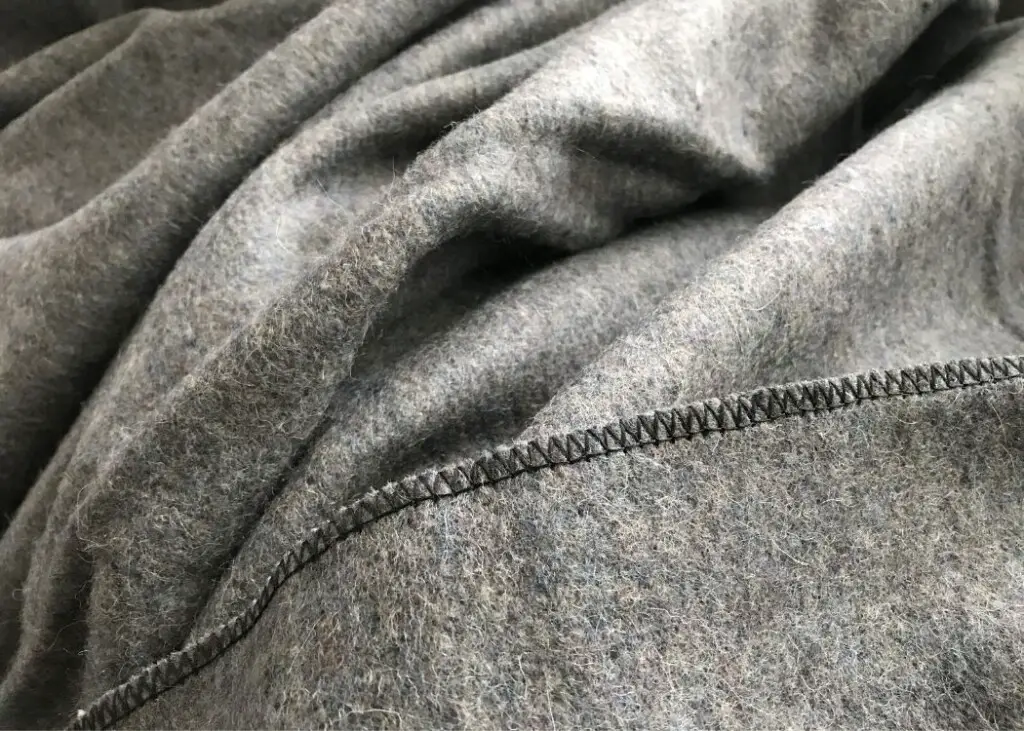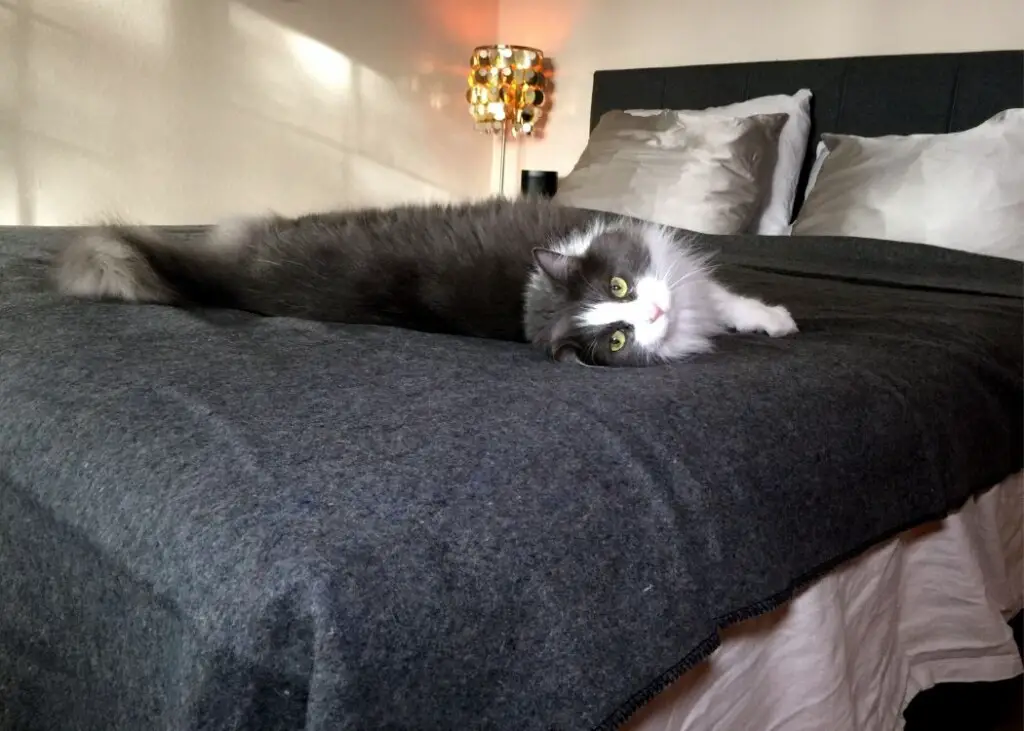**This post contains affiliate links and I will be compensated if you make a purchase after clicking on my links.
One of the best fibers to wear or sleep under is wool. Obviously, it’s cozy and warm. But it can also be considered a cooling fabric. It breathes, but more importantly, it absorbs and wicks moisture away from you.
If you’re working up a sweat on the ski slopes a base layer of wool will keep you warm and dry. And if you accidentally hike through a shallow stream, your wool socks can hold a significant amount of water before you feel wet.
In addition, wool is naturally flame resistant. It doesn’t ignite easily, and unlike synthetic fibers, it doesn’t melt onto your skin. (Ouch!)
So, from a safety perspective, it’s good to have a wool blanket handy in the bedroom. If you wake up and your house is on fire, cover yourself with the wool blanket as you make your escape.
Merino wool
Merino wool comes from Merino sheep and is considered thinner and softer than regular wool. This is important if you plan on having the wool against your skin, either as a primary clothing layer or blanket.
For a larger investment, other types of wool are available from other wooly animals, such as alpaca, angora rabbits, cashmere and pashmina goats, and llama.
Most wool is dry-clean-only. However, when it comes to bedding, it’s more practical to have machine-washable blankets. Especially if you have allergies and must hot-water wash everything to remove all allergens and dust mites.
Washable wool blankets usually contain 10-20% synthetic fibers in order to facilitate washing. And even non-washable blankets are still washable—you just may find they’ve shrunk. A lot.
Sometimes the grams per square meter or GSM will be listed. The higher this number, the heavier and thicker the blanket.
Military-style blankets
One of my old favorites was an ugly brown military blanket. It was the best thing to wrap yourself up in while sitting on the cold bleachers watching a football game.
These types of blankets are great for camping, as either a blanket or groundcover. Throw one in the RV or car for an emergency.
They may not be pretty, but they are an excellent all-around blanket at a great price.
Because I’m feeling nostalgic for my old military blanket, I purchased this one:
- EKTOS 90% Wool Blanket. 4.4 lbs, 66”x90” size. 10% synthetic fiber. Hand or machine-wash on cold/gentle.

“Felt-like” texture. (Photo by author.)

Pet-approved! (Photo by author.)
Out of the package, it is a bit stiff and doesn’t really embrace you the way a typical throw blanket would. I can see how it would make an excellent ground cover or picnic blanket.
And it works well as a layer on your bed. (It’s December, and I’m sleeping with only this plus flannel sheets. I’ve also been using it in combination with my cooling weighted blanket.)
It looks like “felt”, which may explain why it is washable (see below).
Smells like wool
Many online commenters complained about a “funny smell” and washed the blanket several times first. I found that the blanket simply smelled like wool, most likely from the lanolin.
Admittedly, the first night the scent of wool was a tad overpowering. However, this scent quickly dissipated over the following nights. Now, weeks later, it has almost no smell.
Note, that many of these blankets are marketed as “fire retardant” due to their wool content. There shouldn’t be any additional chemical fire retardant added (most of those chemicals were banned years ago) but double-check the fine print.
Another highly rated option I considered:
- Arcturus Military Wool Blanket. 4.8 lbs, 64”x88” size. 20% synthetic fiber. Machine wash on cold/gentle. Hang dry or tumble dry on low heat.
Wool blankets for your bed
Obviously, you can use a military-style blanket for your bed, but if you wish something a bit fancier and heavier (and are willing to pay more) then here are some washable blanket options. Like other bedding, these are sized for your mattress, whether twin, queen, or king.
For high-quality wool products, look for the Woolmark logo. This certifies that the product meets certain standards of quality.
Woolmark also requires additional standards for wool that is marketed as “washable”, including a limit on “felting dimensional change”.
- Poyet Motte Aubisque Heavyweight blanket. 100% wool, 500 GSM. Woolmark certified. Machine-wash in cold, line dry. Made in France.
- Desert Breeze Distributing Alpaca and Sheep Wool blanket. 50% alpaca and 50% merino sheep wool. Machine wash cold/delicate, dry flat. Made in Peru.
Wool comforters
If you prefer a comforter or duvet, you can find one stuffed with wool. Note, even if a comforter is machine-washable it may not actually fit in your machine.
- Sleep & Beyond myComforter®. Machine-washable wool covered with 100% cotton percale. A thinner “light” version is also available.
Important: 45-day return policy, but only for “unused” bedding
For more money, comforters stuffed with merino wool are also available. However, the merino wool is not marketed as machine washable.
Care of Wool Bedding
>>Warning: wool may be resistant to flames but unfortunately is very susceptible to being eaten by moth larvae. Read MORE on how to store and protect your investment.
You may luck out and find a real military blanket at your local military surplus store. If your purchase is used, first freeze or wash it to kill potential moth eggs. You don’t want to bring these critters into your home.
Real military blankets should be tough enough to machine-wash. For those and other washable wool blankets follow these guidelines:
- Use a mild detergent, such as Woolite
- Wash on the wool or delicate setting of your washer
- Wash and rinse in cold water
- Dry on low heat briefly, then take the blanket out and hang dry while still a little damp. Alternatively, if your high-efficiency washer removes enough moisture during the (gentle) spin cycle you may be able to simply hang dry.
You may find the lint screen of your dryer to be full. This is normal.
In general, follow the manufacturer’s instructions for washing your blanket. However, note these instructions are sometimes much more conservative than they need to be. Some “dry-clean” items will easily survive gentle washing.
Dry-cleaning isn’t great as the natural oils, such as lanolin, will be gradually stripped away.
I’ve broken all the rules and now routinely machine-wash my silk pillowcases on hot. (But dry flat.)
Obviously, if you decide to break the rules, you are taking a risk. Start with the delicate cycle on cold water and work your way up to harsher washing conditions.
Although wool fiber—and certainly the sheep it comes from—has no issue with exposure to water, there is a danger that washing wool fabric can cause it to felt, or become matted and shrink. This is due to fluctuating water temperature and agitation.
Hence, start with cold water on the gentle cycle. Washing by hand is also good, but a bit impractical for a large item such as a blanket.
Blankets that shrink are less of an issue than clothing, so bedding is an area where you can afford to take a few risks. A “felted” wool blanket is still very functional.
Also check out Cooling Blankets & Comforters
Some of the “Cooling” comforters turned out to be more insulating than expected. These comforters are made of healthy fabrics and fills, that work for both winter and summer.




